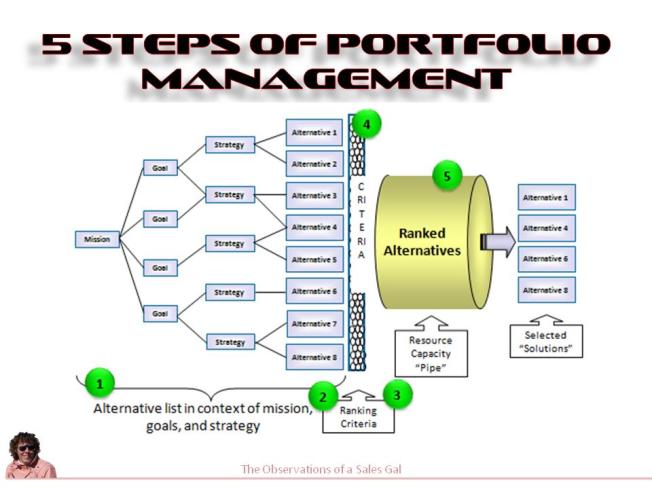
Cathy Liggett – Sales Director, PPM Solutions
Our Customers can connect strategic planning with market and business opportunity definitions.
When Innovation Teams fail to deliver on their promises, the most frequent explanation is that the strategy was wrong. But the strategy by itself is not often the cause. Strategies most often fail because they aren’t executed well. Either the team isn’t capable of making them happen, or the leaders of the organization misjudge the challenges their teams face in the market place, or both.
The right portfolio and capacity planning tool will allow strategic planners to examine multiple scenarios and predict the probability of success within a set of given budgets, constraints and thresholds. Typically, strategic planners throw these guidelines over the fence to those responsible for identifying and defining market and business opportunities within their portfolio. If the strategic planning team shares the executable model developed while creating the strategy with the portfolio management team, the strategic vision can become “our” vision instead of “their” vision.
The benefits of empowerment are realized as Portfolio Managers redistribute and balance the opportunity portfolio. Opportunities can be selected based on the budgets, thresholds, and constraints of the strategic model. Ways for opportunities to compensate for one another can be identified while maintaining strategic alignment. The unified team (Strategic Planners and Portfolio Managers)―with its synergy of effort―offers greater knowledge than if the Portfolio Managers of opportunity definition and the Capacity Planners of strategic planning work separately. The shared, executable model is key to a common vision, and required to truly join capacity planning and portfolio management.
ProModel customers build executable models driven by a discrete event simulator to determine potentials, define competency requirements, and establish portfolio budgets. They use this same model for portfolio management to balance opportunities, and minimize risk. This connection helps establish a common language between strategy and opportunity planning.
Our Customers can align product roadmaps to these market opportunities.
Power is the rate at which work is accomplished. Roadmaps control that rate. We like to think of it as the throttle of execution. This is where the day-to-day activities of the project meet strategy. Yes, it’s true that the roadmap should be seen as a portfolio. The Roadmapping Team must balance opportunity with capability while maintaining strategic alignment.
A shared, executable model helps our customers bridge the gap between the potential and realized returns of the enterprise roadmap, while optimizing the execution rates of the individual projects on that roadmap. Of course risk and reward are balanced, but perhaps the greatest advantage the executable model brings to roadmapping is change impact analysis. For this task, automated reports just can’t address the bursty nature of enterprise change. The averages and estimates of traditional Gantt charts, and strategic plans don’t address the issues of resource availability or future capability needed for roadmapping.
Our Customer’s day-to-day decisions required in Market Sensing, Problem, Feature, Requirement, and Launch definition receive direction and focus from these roadmaps.
A common executable model, used for strategic planning, capacity planning, portfolio management, and roadmapping helps build a common language, focus, and almost frictionless execution. The model helps everyone on the Innovation Team understand where the constraints came from. The final result is empowerment to the front lines, where decisions are being made. The model, which is connected to the roadmap, opportunities, and strategy can now be used for “What if” analysis.
The day-to-day decisions of members on the Innovation Team can be strengthened by the executable model. This executable model is used to gain insight into trends and forces that impact our decisions. By studying the behavior of the model, good decisions can be made without formal analysis. The goal is to empower their Innovation Team with reliable instincts, formulated with facts and modeled experiences, so that when the time comes, good decisions can be made in a timely manner.
Members of the Innovation Team gathering market evidence, analyzing the evidence to define problem statements, constructing innovative feature definitions, specifying market requirements, or planning the launch, use the executable model to conduct what if analyses, and change impact analysis to be sure the maximum competitive advantage is delivered within the current business constraints.
This three-tier coordination between Strategy, Opportunities, Roadmaps, day-to-day market sensing, problem, feature, requirement, and launch definition can be accomplished through the right type of capacity planning and portfolio management capabilities.






